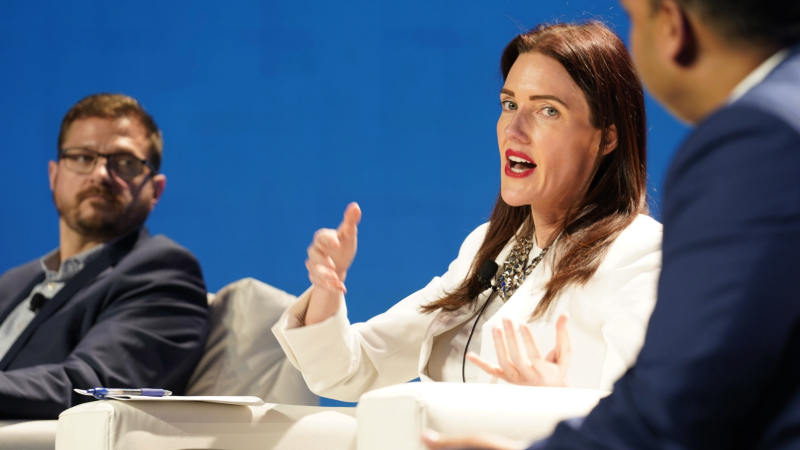
The age of generative AI is here, and top officials from across the Federal government said this week that agencies must begin the work to demystify and embrace the tool among their workforce to transform how business is done.
During the ServiceNow Federal Forum – powered by MeriTalk – in National Harbor, Md., on March 21, Air Force Research Laboratory Chief Information Officer (CIO) and Chief AI Officer (CAIO) Alexis Bonnell said that generative AI presents a new opportunity for increased knowledge.
“When I think about what gen AI might allow us to do to have a relationship with knowledge at that speed and scale, but even more importantly just to reduce the toil – the things that someone doesn’t find fulfilling – I think that there’s going to be a real trickledown effect of retention, of greater sense of purpose,” Bonnell said during the “Securing Intelligent Transformation with Gen AI” panel.
Catherine Manfre, the chief transformation officer at the Office of Personnel Management, followed onto Bonnell’s comments, reemphasizing that a major piece of the generative AI puzzle is the people.
“OPM has been broadly a thought leader on what does the Federal workforce need to look like in the future, and how do we make sure it is agile, it is engaged, and we have the right skills to bring the Federal government into the future,” Manfre said.
Just last month, OPM released a new Workforce of the Future Playbook that features twelve priority areas, including the integration of AI technologies into human resources processes. The priority areas, or “plays,” offer concrete actions agencies can take to improve efficiency in the Federal government.
The new playbook includes “different things agencies can be doing to get talent in, to get talent to stay, to upskill the workforce, to think about data.”
“We included a play about the integration of AI technology in recognition of how big of an impact that this will not only have on some of the HR processes, but the broader mission delivery of agencies and the need to make sure that we have the skills that we need in our collective agencies,” she said.
A top official at the Department of Homeland Security (DHS) said DHS is “committed to bringing in AI talent” and is doing it “differently.”
Last month, the department launched an “AI Corps” – a new initiative focused on hiring 50 AI experts to help leverage the technology across strategic areas of DHS.
David Larrimore, DHS’s chief technology officer (CTO), said in this new venture the department has presented itself as “one voice to industry and the public sector, to the rest of Federal government” to “work together to bring in experts.”
“Once those experts are inside of the department, then some really fun, amazing work when we start to get to deploy them to components to solve a lot of the really high priority mission issues – cybersecurity, talking about border security, countering fentanyl, and all of those types of things,” the Larrimore said.
As CTO, Larrimore said he serves as the right-hand man to DHS’s CIO and first-ever CAIO Eric Hysen. According to Larrimore, since announcing the AI Corps in February, DHS has already received more than 2,000 applications and just this week sent out its first job offer.
Larrimore said DHS is trying to standardize this unique hiring process across the Federal government.
“[AI] has been around for a long time. I think the real difference is we’re being intentional about it now for AI, which is a really good thing,” Larrimore said.
DHS has set policies, trainings, and guidance in place for the use of AI among its workforce, and the CTO encouraged other Federal agencies to leverage those tools.
“DHS now has a policy, we have training, we have supervisor guidance, we have worked out government-friendly terms and conditions with multiple companies, which is now available dhs.gov/ai,” Larrimore said. “We have trained over 3,000 DHS employees.”
The U.S. Patent and Trademark Office (USPTO) is also currently focused on its workforce and demystifying generative AI.
“As we move forward in that realm, it’s important to focus back on to the people and the mission, and demystifying AI – demystifying what gen AI is – where gen AI is not there to replace the people, it’s not there to replace jobs,” USPTO Senior Strategic IT Operations Advisor John Lau said during the panel discussion.
USPTO recently released guidance on how inventors can use gen AI in their work, as well as releasing internal guidance for its workforce. Currently, the agency is allowing its workers to experiment with the tool in a gen AI lab.
“We have set aside an AI lab internally for our employees to be able to subscribe in, to test some of their day-to-day work within a confined space that is within our USPTO boundaries, but enables some to essentially demystify the artificial intelligence,” Lau said.
“We want the employees, we want the people to showcase what they’ve discovered from using these things – what’s worked for them, what’s helped them,” Lau continued, adding, “Ultimately, gen AI – and AI as a whole – is going to transform how business is being done, and employees and people have a big say in how they do that.”
